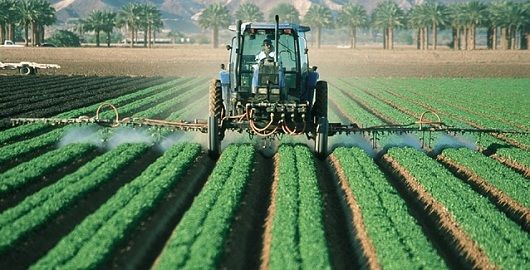A Thorough Appearance at the Obstacles and Benefits of Modern Agriculture
Modern agriculture stands at the crossroads of advancement and sustainability, providing a plethora of chances and obstacles. With improvements like precision farming and biotechnology encouraging improved performance, the market all at once grapples with crucial problems such as environmental deterioration and socio-economic differences. As we check out the intricate balance between technical development and its broader influences, the question emerges: can we achieve a sustainable future that profits both the environment and farming communities? The course onward demands a careful assessment of these dynamics, welcoming stakeholders to think about the possibility for transformative adjustment in agricultural practices and plans.
Technical Advancements in Farming
Advancements such as accuracy farming, automation, and biotechnology have actually changed conventional farming techniques, permitting for even more sustainable and lucrative operations. Precision agriculture makes use of GPS innovation, sensors, and data analytics to maximize field-level administration regarding crop farming.
Automation in farming has further thrust the market forward, with the intro of autonomous tractors, drones, and robotics. These technologies decrease labor demands and enhance operational speed, permitting for timely planting and harvesting. Drones, particularly, offer beneficial airborne images and data, helping farmers in monitoring crop health and detecting issues early.
Biotechnology has actually also played a critical role in progressing agricultural techniques. Collectively, these technological advancements have laid the foundation for a much more resilient and lasting agricultural future.
Environmental Difficulties
Agriculture faces a number of environmental obstacles that endanger its sustainability and productivity. Among the main issues is the degradation of dirt health as a result of intensive farming methods that deplete crucial nutrients and cause disintegration. The overuse of chemical fertilizers and chemicals further worsens this concern, contaminating water resources and decreasing biodiversity. The lasting practicality of farming land is endangered, requiring the fostering of even more sustainable techniques.
Water shortage is an additional substantial obstacle, especially in regions where agriculture heavily depends on watering. Environment adjustment is escalating this concern, altering precipitation patterns and boosting the regularity of dry spells. Reliable water administration systems, such as drip irrigation and rainwater harvesting, are critical to reduce these impacts, however their application remains uneven across different regions.
Furthermore, agriculture is both a sufferer and a factor to climate modification. It represents a significant share of greenhouse gas discharges, mostly from livestock production and rice farming. Transitioning to low-emission agricultural practices, such as accuracy farming and agroforestry, can aid minimize this influence. Nonetheless, these approaches need considerable investment and technological proficiency, presenting a barrier to widespread fostering. Dealing with these environmental obstacles is essential for making sure a lasting agricultural future.

Economic Influences
The financial effects of contemporary farming are profound and diverse, affecting both local and global markets. Developments in technology and production techniques have actually significantly enhanced agricultural performance, leading to a lot more effective food supply chains and minimized costs for consumers.
The capital-intensive nature of you could try here modern farming calls for significant investment in equipment, plant foods, and genetically customized seeds, which can be financially burdensome for small farmers. Furthermore, global market variations can influence the earnings of agricultural exports, making economies reliant on farming susceptible to financial instability.
Additionally, aids and trade plans in industrialized countries can misshape market rates, impacting affordable balance and possibly disadvantaging farmers in developing countries. Overall, while modern-day agriculture drives economic development, it likewise demands navigating intricate financial landscapes to make sure lasting and fair advancement.
Social Effects
While modern agriculture has brought about considerable advancements, it also provides different social ramifications that call for factor to consider. As business farming entities significantly dominate the agricultural landscape, smaller ranches typically battle to complete, leading to the disintegration of country neighborhoods and traditional farming practices.

Such techniques may likewise limit customer options and decrease the ability of regional neighborhoods to control their food resources. As these social ramifications unfold, it ends up being critical to address them to ensure sustainable and fair agricultural growth.
Future Directions
Looking in advance, a number of encouraging opportunities for modern agriculture can attend to the challenges faced today while cultivating sustainable growth. Breakthroughs in modern technology, such as accuracy farming, supply the potential Home Page to maximize resource use and boost performance. By using information analytics and device learning, farmers can make enlightened choices regarding crop administration, resulting in minimized input costs and minimized environmental influence. The integration of renewable energy resources right into farming practices might significantly reduce dependency on fossil fuels and add to decrease greenhouse gas emissions.
Biotechnology also holds immense guarantee for the future of farming. Genetically changed microorganisms (GMOs) and genetics modifying strategies, like CRISPR, could boost crop resilience versus environment adjustment, pests, and conditions, hence boosting food safety and security. Diversifying crop ranges to consist of even more climate-resilient and nutrient-dense choices could reinforce both ecological security and human nourishment.

Verdict
Modern agriculture, identified by technical improvements, provides both challenges and chances. commercial farming vs subsistence farming. Addressing these complexities needs a shift in the direction of sustainable techniques that balance productivity with environmental stewardship and social equity, thus making certain a durable future for international agricultural systems.
Modern agriculture stands at the crossroads of innovation and sustainability, providing a wide variety of chances and difficulties. Furthermore, global market fluctuations can impact the success of agricultural exports, making economies reliant on agriculture susceptible to financial instability.
Furthermore, the extensive use of modern technology and automation in agriculture has led to a decrease in farming employment opportunities.Looking ahead, numerous promising avenues for modern-day farming might resolve the challenges dealt with today while cultivating this article sustainable development. commercial farming vs subsistence farming.Modern agriculture, identified by technical innovations, presents both obstacles and opportunities
Comments on “The Economic Stability of Commercial Farming vs Subsistence Farming in Backwoods”